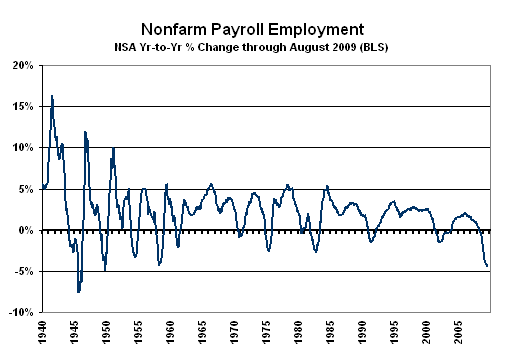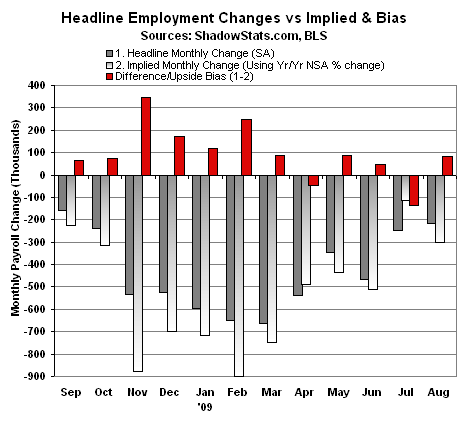Flash Update
JOHN WILLIAMS’ SHADOW GOVERNMENT STATISTICS
FLASH UPDATE
September 4, 2009
__________
Economic Downturn Deepens Anew
Annual Payroll Decline Is Worst of Downturn
Monthly Payroll Decline Was 300,000
Net of Renewed Seasonal Factor Games
Broad Unemployment Jumped 0.5% to
16.8% (U-6), 21.1% (SGS)
__________
PLEASE NOTE: The next scheduled Flash Update is for Thursday (September 10th), following release of the July trade deficit.
– Best wishes to all for a most happy Labor Day Weekend, John Williams
August Unemployment Rate Played Catch-Up; Seasonal-Factor Gaming Understated Monthly Payroll Decline. The August payroll and unemployment reporting showed the economic downturn to be very much alive and festering. Keep in mind that these statistics are coincident indicators of economic activity, not lagging indicators as hyped by Wall Street. As discussed in prior writings, July’s reporting had been distorted to the positive side because of seasonal-adjustments that had been pushed out of sync by the bankruptcies of Chrysler and General Motors. The reversal of those distortions plus ongoing deterioration brought about a worse-than-consensus increase in the unemployment rate. But for the gimmicks tied to the use of the Concurrent Seasonal Factor Bias (see that section), the monthly drop in payrolls also would have been worse-than-consensus, down 300,000 instead of the reported 216,000. Reality likely was in the range of a 500,000-plus monthly payroll loss.
Consider that the seasonally-unadjusted payroll level in July was revised lower by 136,000. If July’s seasonal factors had been left intact, as would be the case in most economic series, then the seasonally-adjusted series would have been revised downward also by roughly 136,000. Instead, where the Bureau of Labor Statistics (BLS) recasts the seasonal factors every month, the adjusted numbers revised downward by just 49,000, understating the relative decline between the adjusted July and August numbers.
- Payroll Survey. The BLS reported a statistically-significant, seasonally-adjusted jobs loss of 216,000 (down 265,000 net of revisions) +/- 129,000 (95% confidence interval) for August 2009, following a revised 276,000 (previously 247,000) jobs loss in July.
From peak-to-trough (the peak month was December 2007; the current month of August is the short-lived trough awaiting worse September numbers), payroll employment has declined by a seasonally-adjusted 6,929,000 jobs, or by 5.0%. Year-to-year contraction (unadjusted) in total nonfarm payrolls deepened in reporting and in revision, down by 4.38% in August (the worst annual decline of this cycle), versus a revised 4.28% (was 4.18%) drop in July.

The unadjusted 4.4% annual decline in August payrolls was the deepest since the 4.9% trough seen in the 1949 downturn. When the 1949 annual low growth is broken in the next couple of months, the annual percentage contraction in payrolls will be the most severe since the production shutdown following World War II. Disallowing that as a normal business cycle, the decline would be the worst since the Great Depression.
Underlying economic series (such as the purchasing managers and help-wanted advertising surveys, and new claims for unemployment insurance) are consistent with a monthly August jobs loss in excess of 500,000.
- Concurrent Seasonal Factor Bias. The pattern of impossible biases being built into the headline monthly payroll employment resumed, following a one-month reversal, with an upside bias of 84,000 jobs in August 2009 reporting. Instead of the headline jobs loss of 216,000, consistent application of seasonal-adjustment factors — net of what I call the concurrent seasonal factor bias (CSFB) — would have shown a more-severe monthly jobs loss of about 300,000. This factor has generated an upside reporting bias seen in 10 of the last 12 months, with a rolling 12-month total upside headline-number bias of 1,146,000. A worksheet on this is available upon request. (See SGS Newsletter No. 50, for further background.)

- Birth-Death/Bias Factor Adjustment. As discussed in SGS Newsletter No. 51, Birth-Death Model biases tend to overstate payroll employment during recessions. Never designed to handle the downside pressures from an economic contraction, the model adds a fairly consistent upside bias to the payroll levels each year, currently averaging about 74,000 jobs per month. The unadjusted August 2009 bias was an addition of 118,000 jobs, up from 92,000 the year before, and up from 32,000 in July 2009.
- Household Survey. The usually statistically-sounder household survey, which counts the number of people with jobs, as opposed to the payroll survey that counts the number of jobs (including multiple job holders), showed August employment dropped by 392,000 in August, versus a decline of 155,000 in July.
The August 2009 seasonally-adjusted U.3 unemployment rate showed a statistically-significant increase to 9.66% +/- 0.23% (95% confidence interval), from 9.36% in July. Unadjusted U.3 eased to 9.6% from 9.7% in July. The broader August U.6 unemployment rose to an adjusted 16.8% (16.5% unadjusted), from 16.3% (16.8% unadjusted) in July.
During the Clinton Administration, "discouraged workers" — those who had given up looking for a job because there were no jobs to be had — were redefined so as to be counted only if they had been "discouraged" for less than a year. This time qualification defined away the long-term discouraged workers. Adding them back into the total unemployed, unemployment more in line with common experience — as estimated by the SGS-Alternate Unemployment Measure — rose to about 21.1% in August, up from 20.6% in July. See the Alternate Data tab at www.shadowstats.com for a graph and more detail.
Broad Money Growth Continues to Falter. Last night’s (September 3rd) weekly reporting on M3 components (seasonally adjusted) M2 and institutional money funds showed continued sharp weekly contractions. Over the coming weekend, following the release of tonight’s banking data by the Fed, I’ll post a preliminary estimate of August’s SGS-Ongoing M3. There is nothing in the latest data that would alter the content of the September 2nd Alert. Many thanks to the various subscribers who have forwarded ideas and details to what is afoot. I shall address the matter further next week.
Week Ahead. July Trade Balance. Due for release on Thursday, September 10th, the July trade deficit should widen somewhat and would offer a significant negative surprise, if reporting lags on imports were brought current. The catch up more likely still is a month or two down the road, given the passing of the summer holiday season this week.
__________